Genetic Monitoring of Bloater Broodstock using a GTSeq (Genotypes by thousands sequencing) Panel
Contributing Authors
Stacey Nerkowski (FWS, stacey_nerkowski@fws.gov), Lauren Atkins (FWS), Meredith Bartron (FWS), Steve Davis (FWS)
Project Description
Hatchery production is a central component of coregonine restoration within the Great Lakes ecosystem, and active supplementation programs are currently underway in Lakes Ontario and Huron. As the development of coregonine broodstock lines and methods associated with hatchery rearing and release are investigated in the Great Lakes, it is essential to monitor genetic diversity among hatchery-reared fish and consider the ramifications of releasing these animals into the wild. Genetic monitoring can be used to track changes in measures of genetic diversity through time (Schwartz et al. 2007). Typical measures of diversity monitored are allelic richness, heterozygosity, and effective population size (Allendorf et al. 2012; Waples 2022), which are used to monitor the source populations that the hatchery populations are derived from, hatchery broodstocks, and subsequent offspring. Comparisons of all three groups can identify potential genetic bottlenecks, declines in genetic diversity, and reproductive variance that could result in genetic diversity changes among the groups, resulting in decreased fitness or performance of the hatchery-produced fish in the wild.
Establishing standardized marker panels is also important because genetic data provide insight into population biology and connectivity, recruitment dynamics, assessments of historical demography, and population-specific mortality, which can take place across a large geographical area (Allendorf et al. 2010; Benestan et al. 2016). Sequencing-based genotyping panels, such as genotyping-in-thousands (GTSeq), are becoming an increasingly accessible approach for nonmodel organisms (Campbell et al. 2015; Meek and Larson 2019). Because this approach uses DNA sequencing, which provides exact nucleotide arrangements, the resulting genotypes can be more easily and consistently compared among studies than other PCR-based assays.
A previously funded Coregonid template proposal is currently developing a GT-Seq microhaplotype panel for genetic monitoring, parentage-based tagging (PBT) applications, and species identification using wild and hatchery stock of Bloater and Cisco. The panel is expected to be completed by fall of FY 2025, and during the development stage will be assessed with a small set of known hatchery-reared families for each species as part of the panel development process. This study represents the application phase of the project, which aims to use the GT-Seq panel to implement a genetic monitoring and parentage-based tagging program for USFWS Bloater production. Specifically, the developed panel will be used to genotype hatchery broodstock and a subset of offspring for Bloater to confirm use of the panel for large-scale application of parentage-based tagging, evaluate reproductive success within the hatchery, and provide estimates of genetic diversity within the hatchery population (including heterozygosity, allelic diversity, effective population size) that are needed to inform genetic management of the broodstock, and compare diversity to the wild source population used for broodstock collection. In addition, obtaining genetic data for all broodstock, using this panel will enable the use of PBT to assist with assessment efforts (e.g., estimating survival, dispersal, population size) of hatchery supplementation efforts.
